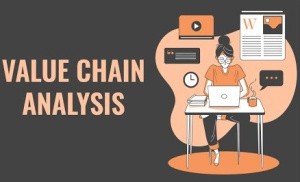Value Chain Analysis Templates Start the discussion!
New Category!
Thinking of a Best Practice which could fit in this category? Tell us

What exactly is the Value Chain?
The Value Chain is the process in which a given company will add value to the raw materials that it utilises, so that goods can be sold to consumers. Therefore, it provides the competitive advantage for the good or service. For instance, a successful transaction will involve added value to both sides of the transaction. For the producer, this value will be in the form of profit; and for the consumer, this will take the form of satisfaction that they gain from their purchase. This emphasis on competitive advantage and mutual benefit makes the Value Chain different from the Supply Chain, which is the process that the good or service has to go through to get the product to the consumer. If you want to find out more about the difference between the Value Chain and the Supply Chain, click the link here.
Michael E. Porter, who coined the term Value Chain, defines it in his 1985 work, Competitive advantage: creating and Sustaining Superior Performance, as ‘a collection of activities that are performed by a company to create value for its customers.’ Thus, the Value Chain can be seen as the process by which a company takes raw materials and turns them into something of higher value than the input and the process. The main purpose of the value chain is to add value to the product and this is often done by marketing or packaging a product.
The process can be split into five steps, as shown below here:
1. Inbound logistics is the organisation of moving materials from suppliers to manufacturing or assembly plants.
2. Operations describe the process of converting these inputs into outputs.
3. Outbound logistics relate to moving the final product to the end user.
4. Marketing and Sales refer to the communication involved in bringing the end product to the consumer.
5. Service makes reference to the services that the business offers once the good or service has been sold to the consumer.
As well as the primary activities involved in the Value Chain process, there are also secondary activities involved as well. These occur throughout the process, and are what permit the value within the product to be added.
The secondary activities can be split within five sections, as outlined below here:
Human Resources management This, in a broad sense, is the management of people, and includes the recruitment, hiring and training of workers.
Technological Development This is the research and development for the product, and depending on the sector, this could include product design or improvement of the business processes.
Infrastructure This refers to the company ‘building blocks’ which includes financials, as well as the management involved.
Sourcing This involves how companies find and gather components for the business processes.
These two sections come together to bring value to the product. This process allows companies to differentiate their product from others, and therefore create a margin between what they are buying and selling their product for.
But how can a company analyse their Value Chain Process?
1.Understand the activities that are involved in the process and conduct research. From this, the company is able to find the value of each activity and the costs involved.
2.Next, a company should set out to identify potential opportunities that are available to find a greater comparative advantage, therefore altering each relevant stage of the value chain for this purpose identified.



